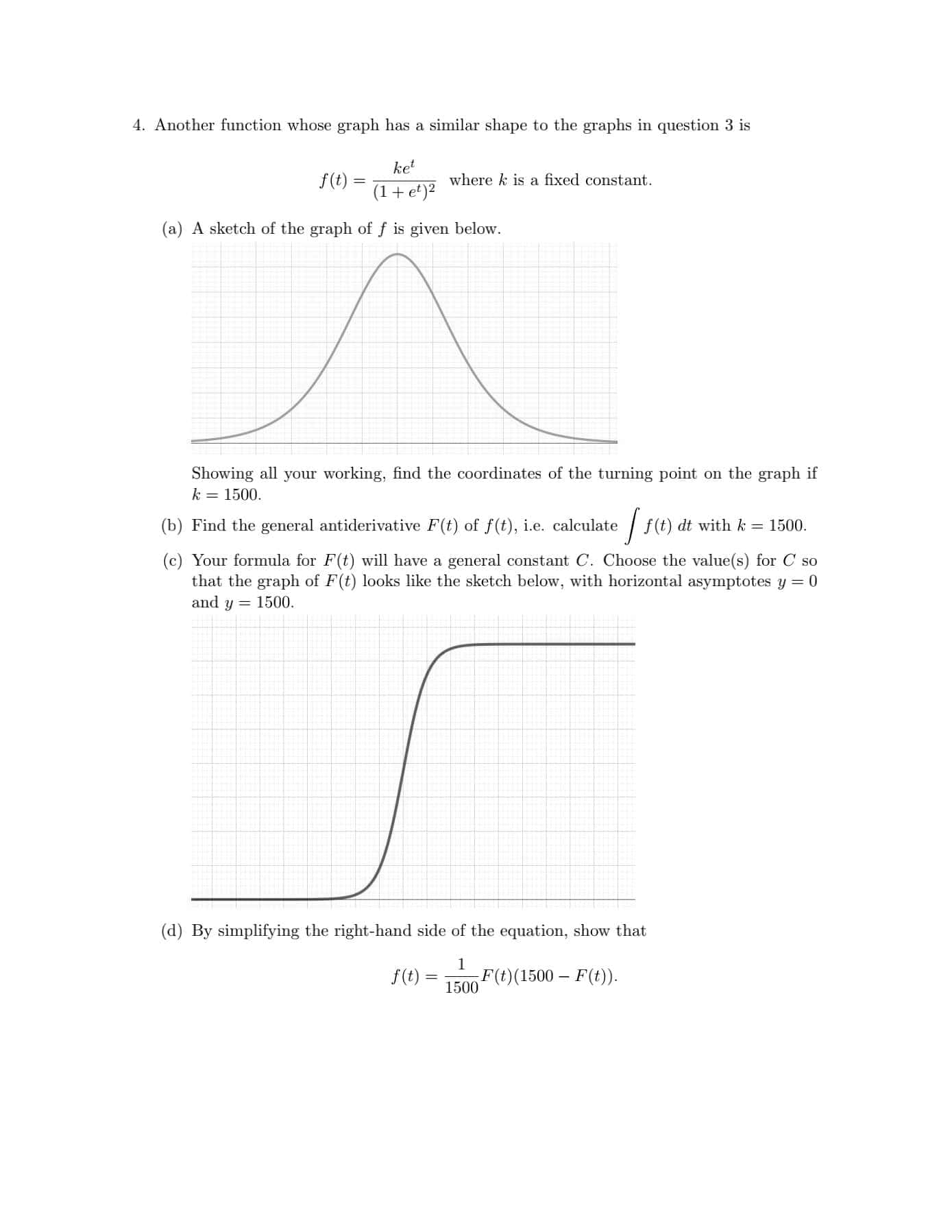Another function whose graph has a similar shape to the graphs in question 3 is ket f(t) = (1+et)² where k is a fixed constant. (a) A sketch of the graph off is given below. Showing all your working, find the coordinates of the turning point on the graph if k = 1500. (b) Find the general antiderivative F(t) of f(t), i.e. calculate f(t) dt with k = 1500. (c) Your formula for F(t) will have a general constant C. Choose the value(s) for C so that the graph of F(t) looks like the sketch below, with horizontal asymptotes y = 0 and y = 1500.
Another function whose graph has a similar shape to the graphs in question 3 is ket f(t) = (1+et)² where k is a fixed constant. (a) A sketch of the graph off is given below. Showing all your working, find the coordinates of the turning point on the graph if k = 1500. (b) Find the general antiderivative F(t) of f(t), i.e. calculate f(t) dt with k = 1500. (c) Your formula for F(t) will have a general constant C. Choose the value(s) for C so that the graph of F(t) looks like the sketch below, with horizontal asymptotes y = 0 and y = 1500.
Functions and Change: A Modeling Approach to College Algebra (MindTap Course List)
6th Edition
ISBN:9781337111348
Author:Bruce Crauder, Benny Evans, Alan Noell
Publisher:Bruce Crauder, Benny Evans, Alan Noell
Chapter1: Functions
Section1.2: Functions Given By Tables
Problem 32SBE: Does a Limiting Value Occur? A rocket ship is flying away from Earth at a constant velocity, and it...
Related questions
Topic Video
Question
100%
My question is stated in the two images uploaded, please help answer it from 4 (a) to 4 (e).

Transcribed Image Text:Another function whose graph has a similar shape to the graphs in question 3 is
ket
f(t) =
(1+et)²
where k is a fixed constant.
(a) A sketch of the graph off is given below.
Showing all your working, find the coordinates of the turning point on the graph if
k = 1500.
(b) Find the general antiderivative F(t) of f(t), i.e. calculate
f(t)
dt with k = 1500.
(c) Your formula for F(t) will have a general constant C. Choose the value(s) for C so
that the graph of F(t) looks like the sketch below, with horizontal asymptotes y = 0
and y = 1500.

Expert Solution
This question has been solved!
Explore an expertly crafted, step-by-step solution for a thorough understanding of key concepts.
Step by step
Solved in 4 steps with 5 images

Knowledge Booster
Learn more about
Need a deep-dive on the concept behind this application? Look no further. Learn more about this topic, calculus and related others by exploring similar questions and additional content below.Recommended textbooks for you

Functions and Change: A Modeling Approach to Coll…
Algebra
ISBN:
9781337111348
Author:
Bruce Crauder, Benny Evans, Alan Noell
Publisher:
Cengage Learning

Algebra & Trigonometry with Analytic Geometry
Algebra
ISBN:
9781133382119
Author:
Swokowski
Publisher:
Cengage

Functions and Change: A Modeling Approach to Coll…
Algebra
ISBN:
9781337111348
Author:
Bruce Crauder, Benny Evans, Alan Noell
Publisher:
Cengage Learning

Algebra & Trigonometry with Analytic Geometry
Algebra
ISBN:
9781133382119
Author:
Swokowski
Publisher:
Cengage